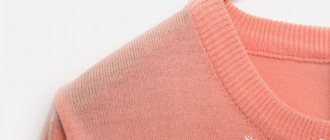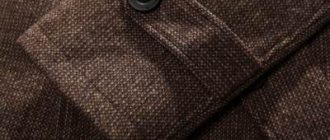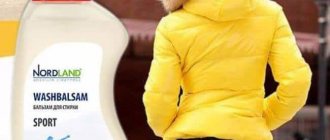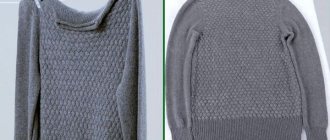Washing a jacket at home is a simple procedure if you prepare for it correctly, determine the type of fabric and the manufacturer’s recommendations for removing stains.
Most suiting fabric items can be machine washed directly, while others should be processed by hand.
Our article will tell you whether and how to properly wash in a washing machine and by hand, dry and iron a jacket at home.
Preparation
Before using the washing machine, it is important to ensure that the jacket can be treated in this way. First, they study the tag on the clothing, where the manufacturer places identification icons:
- The circle in which the square is placed is not machine processed.
- Crossed out basin with water - hand washing is prohibited. Clothes can only be processed using dry methods, including dry cleaning.
If the clothing label has not been preserved, you can determine recommendations based on the type of fabric from which the jacket is made. But it is important to consider that the lapels, lining and collar of the product may consist of other materials.
Choosing the right product
For machine washing, it is better to choose liquid products designed for dark or colored items, depending on the type of jacket.
The advantage of such detergent products is their quick rinsing and the absence of streaks after washing.
If you don't have gel on hand, you can use powder. It is diluted in water and added to the detergent compartment in the machine.
To prevent wrinkles, use conditioner-rinse , which additionally removes static from the synthetic lining.
Is it possible to wash a jacket?
Any product has a certain marking; on clothing there is a label with information on proper care. It is according to the instructions on this label that they determine whether the jacket can be washed and in what conditions.
If the label contains a sign such as a crossed out basin, this means that washing is prohibited. If there is a sign in the form of a basin with a hand, then only hand washing is allowed. There may also be other signs indicating the permissible water temperature when washing, the possibility of drying or ironing.
Attention! Typically, a jacket does not need a full wash; a gentle brushing and treatment of stains and creases are sufficient.
Is it possible and how to properly wash it in an automatic washing machine?
Jackets are washed in an automatic machine separately from other items, without using a case.
It is advisable to process them together with trousers if the products are included. Washing at the same time will help avoid uneven fading of items.
Instructions for processing jackets that can be washed in a machine look like this:
Remove foreign objects from pockets. If the pockets are zipped, then they are closed.- They load the jacket into the machine.
Close the door and pour in the minimum amount of detergent. If the dosage is indicated, for example, 80 ml per 5 kg of laundry, then you can take 30-40 ml per jacket. - Set the mode.
To process the jacket, choose a delicate wash at 40 degrees, unless otherwise indicated. If the clothes can be washed by hand, set the appropriate mode without spinning. Can be soaked for 30-50 minutes.
It is recommended to install an additional rinse cycle to eliminate powder residues.
Material value
Modern fashion provides an opportunity for both women and men to include jackets in their wardrobes for any occasion: classic suits for business and special occasions, fashionable sports models, elegant blazers, summer jackets.
Suiting fabrics are subject to increased demands; they must retain their shape, have high wear resistance and an aesthetic appearance. The range of costume materials is quite wide: from traditional wool to silk and satin.
Each type of fabric is characterized by its fiber composition, which determines the properties of the material and care rules:
- For wool and wool blends, the use of hot water is unacceptable to avoid deformation of the product. It is preferable to use liquid or gel detergents.
- Linen and cotton fabrics can withstand high water temperatures and even boiling well.
- Jeans and gabardine are machine washable at moderate temperatures and medium spin cycles.
- Blazers and jackets made of stretchy stretch fabrics are washed in cool water and do not wring out.
- Corduroy can only withstand delicate washing without spinning.
- Cashmere, angora, and suede are prohibited from being washed even by hand. Dry cleaning or dry cleaning only is recommended for them.
- Polyester and other artificial fabrics can be washed in hot water and pressed at a moderate-high speed.
- Natural and artificial leather can only be wiped with a damp cloth.
The most machine washable fabrics are cotton and polyester. It is safer to wash jackets made from other types of fabric by hand in a wide basin or bathtub.
Washing a jacket in the shower has worked well. To use this method, the product is placed on hangers, treated with a soap solution, and then rinsed thoroughly using a shower head.
When the water has drained, the item is dried in a well-ventilated area.
Manually so that the product does not lose its shape
If clothes cannot be washed in an automatic machine, then you can use the classic method. Point contamination is easier to remove using separate means.
Before using the stain remover, test it on an inconspicuous area of clothing, apply it for the recommended time and evaluate the result.
The steps of washing by hand are no more difficult than washing jackets in a machine:
Add washing gel to the water. Place the jacket and leave for 50-60 minutes. Items made from delicate fabrics should not be soaked.- Gently wash by lifting and lowering the jacket into the water. The temperature should not be higher than 40 degrees.
- Rinse twice as thoroughly as other items.
The water needs to be changed at least 4 times. It is better to rinse your jacket in a full bath rather than in a basin.
After washing, lay the jacket on a wooden rack, if there is one in the bathroom. It is important that the edges do not hang down and that the product lies “crowded”.
The water will drain and you can hang it on a hanger . If there is no wire rack, you can lightly wring out the clothes without twisting them, and then place them on a thick towel on the floor.
Features of cleaning jackets made from different fabrics
The peculiarities of washing different materials are determined primarily by the texture of the fabric and the specifics of the fiber.
A linen jacket must be washed in water with an average temperature of 30-40C; dry cleaning or removing stains with a solvent can ruin it.
Linen materials wrinkle easily, are difficult to iron, and often shrink or stretch. Dry them wet and straightened. It is better to iron a jacket with a slightly damp iron or steam it at a temperature of no more than 30C.
When planning to wash a polyester jacket, keep in mind that although synthetic fibers do not shrink, high temperature, bleaching, active friction and twisting can affect the structure and color. Acceptable temperature is 40C.
Wet cleaning without soaking
Wet cleaning is recommended for removing stubborn stains from clothes that cannot be washed:
- prepare a soap solution from 1-2 tsp. liquid soap and a glass of warm water;
- moisten a clothes brush in the solution and treat the surface of the jacket hanging on a hanger;
- then do the same, but with a damp brush without soap to remove any remaining product.
If the contamination is strong, then instead of a soap solution, you can use ammonia diluted 1:1 with water.
How to remove stains
Read about: how to remove pen ink from clothes at home.
Difficult to remove stains from a jacket can be wiped off using household chemicals. If the stain is fresh, it is advisable to try to deal with it immediately.
- Grease stains are removed using talc (corn starch) and an iron. You need to place a paper towel under the contaminated area, generously sprinkle the stain with talc or starch on top, cover with paper and iron with a hot iron (the temperature should be appropriate for this type of fabric). Perform the procedure several times, replacing the paper and talc with new ones. The powder absorbs all the fat, after which the jacket can be put in the machine.
- Blood stains are washed off with cold water. You need to soak the contaminated area in a container with cold soapy water, then rub the stain with a soft brush and wash.
- Grass, ink, and rust stains can be removed using ammonia. Moisten a cotton pad with ammonia and wipe the stain from the edges towards the center.
On a note
Before using any household chemical, you need to test its effect on a fabric sample sewn on the inside of the jacket. If the fabric does not “shed” and its structure does not change, the entire surface can be treated.
Shower treatment
If clothes are heavily soiled, they can be treated with a shower in the bathroom . Pre-treat stains using wet cleaning.
The next wash looks like this:
- prepare a soap solution, treat the jacket with a brush dipped in it;
- rinse the jacket with a shower, hanging it over the bathtub;
- when the water has drained, blot it with a dry towel and transfer it to a ventilated room.
You can clean the jacket lining in the same way if a full wash is not required. It is enough to turn the product inside out and perform all stages of the “shower” wash.
How to clean a jacket: basic methods
How to wash a jacket correctly so as not to lose its shape. First of all, a number of restrictions must be observed.
It is forbidden:
- Use hot water (above 40C);
- Some materials should be wet;
- Twist;
- Squeeze;
- Dry folded;
- Touch the hot surface of the iron to the fabric.
- All information about restrictions can be found on the product label.
There are many recipes for cleaning clothes yourself. So, ammonia diluted with water will get rid of stains, annoying odors and refresh capricious fabric. But in case of serious contamination, it is better to use more effective methods.
Here are some best ways:
- Dry cleaning;
- Wet cleaning;
- Wash in the shower;
- Handwash.
Dry cleaning
Cleaning a tweed or corduroy jacket is usually done using the dry method. Brushing is the best way to remove small and large dirt without leaving a trace. First, the jacket is knocked out with sharp shaking. Next, use a clothes brush with medium-hard bristles to remove dust lodged between the fibers and fine hairs caught in the fibers.
Wet cleaning
First you need to get rid of contaminants. Carefully inspect the areas most at risk, the collar, lapels, cuffs and elbows. Carefully clean contaminated areas.
Brush off any dust from your jacket, then go over it with a brush. Place the jacket on the hanger and shape it.
Steam with a jet of steam and leave overnight in the bathroom. Overnight, moisture will straighten out bruises and the fabric will get rid of unpleasant odors.
For corduroy, sometimes a special sticky roller is used, in the absence of ordinary stationery tape. Dried stains can first be cleaned with a brush, then gently washed with a sponge, making point-to-point, blotting movements.
Washing in the shower
Gentle washing is especially important for casual clothes, such as a school jacket. It will spare the glued parts and preserve its shape.
Washing under the shower is done in the bathroom as follows:
- Clean the surface of the jacket from adhering dust particles;
- Hang it on a hanger next to the shower;
- Using a watering can, moisten thoroughly with water;
- Dilute the liquid detergent and dip the brush in it;
- First, rub the most soiled areas, then the entire fabric of the jacket;
- Rinse off with a watering can.
- Do not use hot water to avoid damaging the sizing.
Handwash
A suit for everyday wear requires regular and high-quality care. It is better to wash the jacket independently from the suit and by hand; the trousers can withstand repeated use of the machine.
Among home methods, many people prefer hand washing with soaking. Pre-soaking helps remove old stains and stubborn dirt without leaving a trace. Thanks to prolonged soaking in water, dirt comes away from the fibers, after which it can be easily cleaned.
Steam treatment
For steam treatment, use a steam generator or an iron with a similar function . The clothes are hung on hangers and steamed well, then immediately treated with a rubber brush without waiting for them to dry.
If there are stains, remove them first with salt or ammonia. Dry jackets after steam treatment in a horizontal position.
Steam cleaning is ideal for leather, suede, corduroy and nubuck. Also, steam cleaning from the inside is carried out if there are sparkles, varnish coating, sequins and other decorative elements on the front side of the jacket.
For steam cleaning, it is best to use a steam generator, steam brush or steamer.
A similar treatment is used to combat creases and folds on jackets when complete cleaning or washing is not required. Just hang your clothes on hangers and steam them - this will refresh them and get rid of wrinkled areas.
Washing procedure
Properly washing a jacket in a washing machine without fear of irreversibly damaging the item is possible if you follow the basic washing rules:
- Buttons, snaps, zippers must be fastened, decorative parts and accessories must be secured or unfastened, pockets should be sewn up.
- You can place the jacket in a laundry net or thin pillowcase.
- Items must be loaded into the machine with the condition that they occupy only half the volume of the drum. In this case, the fabric will wash better and wrinkle less.
- If the volume of the drum allows, you can load two or three items that match the color and composition of the fabric fibers.
- Place the selected detergent in the powder compartment or directly into the drum, add conditioner in the recommended proportion.
- Select the delicate washing mode or, in the absence of this option, the wool and silk washing mode, as the most gentle.
- Set the heating toggle switch to the temperature optimal for the fabric of the product, or 30°-40°.
- Depending on the type of fabric, set the minimum spin mode or turn off the spin completely so that the items wrinkle and deform as little as possible.
We invite you to read: A thing faded during washing: how to return it to its previous appearance? What should you do if a colored or white item has faded? How can you restore the color of a faded item? Precautions when washing faded items: tips
To reliably rinse out the detergent, you can use the extra rinse mode.
Dry cleaning
Dry cleaning is used if wet cleaning of the jacket is completely prohibited:
the jacket is laid out on a hard horizontal surface;- Use a fluffy clothing brush to intensively scrub the surface of the clothing. The brush should be soft enough, but the bristles should be located tightly to each other;
- After brushing, use a sticky roller to remove dust and dirt particles.
Clothes are left to hang on a hanger in a ventilated area for 2-3 hours .
Dry cleaning
A jacket or cardigan should be cleaned once every 2 weeks. If it is not possible to wash the material, then it would be best to use dry cleaning services. This method has a number of advantages:
- less fabric wear even with frequent processing;
- deep cleaning of all layers;
- No need to waste time doing laundry yourself.
The main disadvantage is the cost of the service, but a good jacket is also not cheap. It is advisable to have it dry cleaned periodically to preserve the appearance of the item longer.
Removing Sweat Stains
When removing sweat stains, it is important to consider the color of your clothing. For light-colored fabrics you can use the following recipes:
- Peroxide for sweat stains . The product is diluted 1:1 with water and applied to the stain areas. After the mixture is completely absorbed, wipe the area with a dry cloth. It is not necessary to wash the product.
- Salt and soda . You can use the recipe without ammonia by preparing a mixture of salt and soda diluted with water. Apply for 15-20 minutes and wash off. You can also rub dry baking soda into sweat stains and leave overnight.
Products of dark shades cannot be treated with hydrogen peroxide and soda. Steam technology, aspirin and ammonia are better suited for them.
Ammonia for stains on dark fabric
Several effective mixtures can be prepared from ammonia:
- 1:1 with water - treat the armpits, then wash off the product with a damp cloth;
- 4:4 with denatured alcohol and 1 part water - treat the jacket from the inside out;
- 1:1:1 with salt and water - clean with a sponge or cotton wool, then wash off the residue with water.
We must not forget about test application of any product on an inconspicuous area of the fabric.
Aspirin
Aspirin tablets are safe for colored fabrics and even fight old stains:
- Grind 4-5 tablets, mix with water until thick.
- Apply to the armpits for an hour.
- Rinse and dry the product.
After drying, you can treat the armpit area with steam.
Using steam
A powerful jet of steam can quickly remove sweat marks.
Use a steam generator or iron filled with distilled water and a drop of lemon juice. In this way, you can remove stains even from suede and leather products.
Manufacturers' recommendations
Under the collar or on the side seam of the lining of a jacket purchased in a store, there is always a label with the manufacturer’s instructions, made in the form of standardized symbols.
For washing a jacket, the main instructions are about allowing or prohibiting machine washing, any washing, as well as temperature parameters and spin resolution.
The following symbols must be found on the label:
- A circle with a square inside - prohibition of washing in a washing machine;
- A crossed out bowl of water means that any washing is prohibited;
- A basin of water with a single underline - gentle wash;
- A bowl of water with double underlining - delicate wash;
- A basin with dots in the middle determines the degree of heating of the water;
- A crossed out stylized image of a thing being twisted is a prohibition on spinning.
If it is not possible to determine the washing mode from the label, you should follow the recommendations of the manufacturers of the material from which the jacket is made.
Before washing custom-made items, it is recommended to test the detergent on a piece of fabric.
Washing features for different types of materials and types
Most materials can be washed in an automatic machine using gentle modes:
linen is a natural material that can withstand even high temperatures; after washing, a linen jacket must be hung on hangers, as the fabric wrinkles a lot;- knitwear, cotton - clothes are washed in a delicate cycle with minimal spin;
- polyester – suitable for machine and hand wash at temperatures up to 40 degrees.
Other types of materials are processed only by dry or steam methods, sometimes hand washing is allowed:
- wool - dry brushing;
- wool with the addition of other fibers - hand wash at 40 degrees or less;
- suede, velvet, corduroy - dry brushing;
- satin - hand wash without spinning;
- leather – to be cleaned with a brush or soft cloth.
Corduroy, denim
Denim and corduroy jackets are very popular; they also need to be washed according to special rules. So, how to clean a corduroy and denim jacket at home:
- Corduroy . You can clean with a damp brush in the direction of the scars, and remove dirty areas with a sponge soaked in a soap solution. You cannot rub, you need to perform blotting movements.
- Denim . Washing is allowed in a delicate cycle in an automatic machine, as well as in the “Jeans” mode at temperatures up to 30 degrees. The product is first turned inside out.
If the jacket has leather inserts, then it is prohibited to press the product in the machine.
From a men's suit
In most cases, men's products do not have decorative elements or details that limit the possibility of washing.
If there is no icon on the label about the prohibition of wet processing, then wash the jacket as follows:
in the machine - use a liquid product, delicate mode without spinning and a temperature of up to 40 degrees;- manually - wash, if machine processing is prohibited, also use a liquid detergent and a temperature of up to 40 degrees, do not twist the jacket when wrung out;
- steaming - will return freshness to the product, eliminate dust and unpleasant odors, if a full wash is not needed;
- dry cleaning with a brush and roller to collect foreign fibers - used if the product cannot be wetted.
If in doubt, it is better to have your jacket dry cleaned.
School
Carefully study the tags on clothes; if there is no prohibition on wet processing, wash as follows:
- machine wash - with liquid detergent in delicate or manual mode without spinning at a temperature of 30 to 40 degrees;
- hand wash - with washing gel, soaking for up to 30-60 minutes, rinsing well and without twisting;
- wet cleaning - stains and heavy dirt are removed with a soap solution using a brush, then the product is cleaned with a brush dipped in clean water;
- dry cleaning with a roller and brush - used with a complete ban on washing.
Dry the school jacket on hangers in a vertical position. If creases form or unpleasant odors appear, it is treated with steam.
Caring for a men's suit
Daily care of things is quite simple; by following just a few rules you will be able to keep your wardrobe in perfect condition.
- When putting your suit in the closet, spend a couple of extra minutes cleaning the dust from your jacket and trousers.
- Remove heavy stains in a timely manner; old stains are more difficult to remove without leaving a trace.
- Don’t skimp, a detergent designed for a specific type of fabric will clean the capricious fabric well.
- Don't store expensive suits on fancy open wardrobe stands. Select a suitable closed compartment or cabinet, away from dust and sunlight. To avoid sagging, use high-quality hangers that follow the shape of a person’s shoulder.
- Don't wear one jacket for several days; allow yourself to alternate clothes. During the break, the suit fabric will regain its shape. Careful care will significantly extend the life of your suit.
- How to wash a pen from a shirt
- The washing machine does not open after washing
Drying and ironing at home
After machine washing, the jacket is immediately hung on hangers, all the details straightened out well.
After hand washing, it should be allowed to “drain” or lie on a thick towel for at least an hour so that the water does not weigh down or stretch the product.
The jacket should be dried away from sunlight; it should be treated with steam before drying . It is recommended to iron the product only in extreme cases, if severe creases have formed.
For ironing, use a thin rag or gauze folded in 3-4 layers. Particular attention is paid to the seams and collar. The ironed jacket is returned to the hangers and left for 2-3 hours in a ventilated area.
Manual method of washing a jacket
You can also wash the item by hand. Before the actual washing process, carefully check the pockets, empty them of foreign objects, and soak the jacket in warm water. Use brown laundry soap as a detergent.
Try not to crumple the item, just place it evenly in the container and that’s it. After soaking, the dirt will be easier to wash off. Clothes should soak for about half an hour. After the time has passed, carefully brush the jacket. You don’t need to knead it too much with your hands or crumple it, otherwise it will be difficult to iron out all the wrinkles later.
After washing, rinse in clean water, hang it on hangers without wringing, and let the product dry. If you have to dry it in the house, place a basin under the clothes where the water will drain or hang it over the bathtub.
Cleaning items that cannot be washed
Jackets made of wool and other delicate fabrics can be cleaned by steam or dry cleaning, if machine or hand washing is prohibited.
To remove stains from wool jackets, you can use Luxus Professional - a product designed for cleaning natural carpets. It is applied to a dry cloth and removed with a damp cloth.
If wet processing of a suit is prohibited, and dirt can no longer be removed using a dry method, then it must be sent to dry cleaning . There the jacket is processed using professional equipment and recommended products.
You will find more useful information about washing outerwear in this section.
Choice of product
- Liquid detergents or gels are recommended for cleaning jackets. They dissolve in water much faster than powders and then are easier to rinse, without remaining in the fibers and without harming the structure of the fabric.
- There are special products for black items that help maintain the brightness and richness of dark shades.
- For wool and wool blend products, you need to choose a product containing lanolin.
- Products containing chlorine cannot be used.
Useful
If the jacket is made of natural cotton or linen fabric, it is recommended to use fabric softener. It will soften the fabric and make it easier to smooth out wrinkles.
How to wash a suit in the shower?
Washing a suit in the shower is quite easy
The idea of cleaning your suit in the shower may seem ridiculous, but it is an effective and quick operation for removing dust, dirt and stains from your clothes in just a few minutes. In what cases is it necessary to resort to this method:
- if the surface of the suit is heavily soiled;
- if the lining side is very dirty;
- if the wet method described above failed to clean the surface of the product.
This is why washing in the shower is an excellent solution for deep and gentle cleaning of the product. Algorithm of actions:
- Thoroughly shake out all dirt and dust, especially in the sleeve area.
- Then clean the item using a wet method.
- Hang the suit on hangers and place it under the shower so that drops of water freely fall on the clothes.
- You need to turn on the warm water and carefully water the problem areas with a hose or completely drench the suit.
- Apply a little detergent to a soft brush or cloth: liquid powder concentrate works well.
- Using smooth hand movements, remove all dirt and greasy stains. But you shouldn’t put too much pressure on your clothes to avoid abrasions.
- Gently rinse off the cleanser and hang the suit in a warm, dry place to dry.
You need to wash your suit in the shower as carefully as possible: in this case, the suit should not be twisted or wrung out - this can lead to permanent damage to the item. All remaining water should drain naturally and without using a hair dryer or other heating element. A slightly damp product should be lightly steamed with an iron or steam generator.
Manual mode
If you don't want to wash your jacket in the washing machine, you can always do it manually. Let's look at how to wash a jacket using the manual technique.
It works well to hand wash linen, cotton jackets, and polyester clothes. Jackets made from satin fabric can be washed either by hand or dry cleaned.
When soaking delicate items, do not be overzealous.
Sequencing:
- Before washing, it is advisable to soak the item for some time in warm soapy water so that the dirt will mostly come off on its own, since rubbing and wrinkling a wet jacket is not recommended. All washing will come down to immersing the item in water and pulling it out of it.
- After washing, it is necessary to rinse the clothes thoroughly. Don’t be lazy, you will have to change the water to clean water 2-3 times. To get rid of the bulk of the moisture, carefully place the jacket in a bathtub or basin, straighten it, and let the water drain. Do not twist the product or shake it too much.
- When the main water has drained, you can place the jacket in the bathroom on a hanger, straighten it and leave it for a while, and then move it to the room or to the balcony. At the same time, it is better to hide it from the heat of batteries and sunlight. It is recommended to iron a slightly damp product, rather than completely dry.
Modern jackets are made from a variety of fabrics, the care for which can vary dramatically. Depending on the instructions on the clothing label, you can wash it at home, but it is always recommended to do this with extreme care.
When using a new detergent, test it on an inconspicuous area, and only then proceed to full use. Do not rub the jacket material, do not twist it, do not wring it out. If you want to try your hand, you can first take a jacket that you wouldn’t mind throwing away and experiment.
If you do not find the strength to do such cleaning, or are very afraid of ruining an expensive, high-quality item, then you should not risk it, immediately take it to the dry cleaner, and let the specialists process your clothes correctly and efficiently. Otherwise, you can try cleaning or washing your jacket at home.
Another interesting article on a similar topic: How to wash a sleeping bag.










